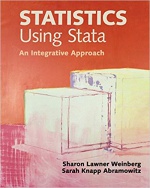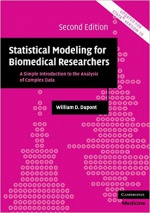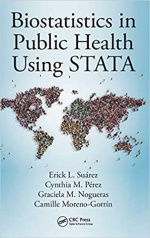Author: Sharon Lawner Weinberg (Author), Sarah Knapp Abramowitz (Author)
 |
QA276.4 W455S 2016
Book Description Engaging and accessible to students from a wide variety of mathematical backgrounds, Statistics Using Stata combines the teaching of statistical concepts with the acquisition of the popular Stata software package. It closely aligns Stata commands with numerous examples based on real data, enabling students to develop a deep understanding of statistics in a way that reflects statistical practice. Capitalizing on the fact that Stata has both a menu-driven ‘point and click’ and program syntax interface, the text guides students effectively from the comfortable ‘point and click’ environment to the beginnings of statistical programming. Its comprehensive coverage of essential topics gives instructors flexibility in curriculum planning and provides students with more advanced material to prepare them for future work. Online resources – including complete solutions to exercises, PowerPoint slides, and Stata syntax (do-files) for each chapter – allow students to review independently and adapt codes to solve new problems, reinforcing their programming skills. (amazon.com)
|
Author: William D. Dupont (Author)
 |
R853.M3 D938S 2009
Book Description The second edition of this standard text guides biomedical researchers in the selection and use of advanced statistical methods and the presentation of results to clinical colleagues. It assumes no knowledge of mathematics beyond high school level and is accessible to anyone with an introductory background in statistics. The Stata statistical software package is again used to perform the analyses, this time employing the much improved version 10 with its intuitive point and click as well as character-based commands. Topics covered include linear, logistic and Poisson regression, survival analysis, fixed-effects analysis of variance, and repeated-measure analysis of variance. Restricted cubic splines are used to model non-linear relationships. Each method is introduced in its simplest form and then extended to cover more complex situations. An appendix will help the reader select the most appropriate statistical methods for their data. (amazon.com)
|
Author: Erick L. Suárez (Author), Cynthia M. Pérez (Author), Graciela M. Nogueras (Author), Camille Moreno-Gorrín (Author)
 |
RA409 S939B 2016
Book Description Striking a balance between theory, application, and programming, Biostatistics in Public Health Using STATA is a user-friendly guide to applied statistical analysis in public health using STATA version 14. The book supplies public health practitioners and students with the opportunity to gain expertise in the application of statistics in epidemiologic studies.
The book shares the authors’ insights gathered through decades of collective experience teaching in the academic programs of biostatistics and epidemiology. Maintaining a focus on the application of statistics in public health, it facilitates a clear understanding of the basic commands of STATA for reading and saving databases. The book includes coverage of data description, graph construction, significance tests, linear regression models, analysis of variance, categorical data analysis, logistic regression model, poisson regression model, survival analysis, analysis of correlated data, and advanced programming in STATA. Each chapter is based on one or more research problems linked to public health. Additionally, every chapter includes exercise sets for practicing concepts and exercise solutions for self or group study. Several examples are presented that illustrate the applications of the statistical method in the health sciences using epidemiologic study designs. (amazon.com) |
